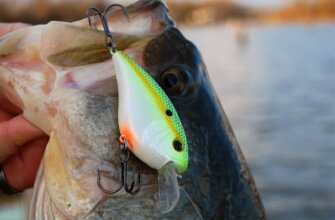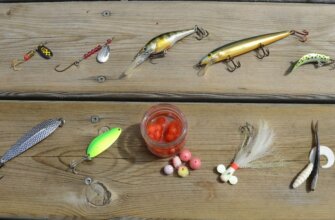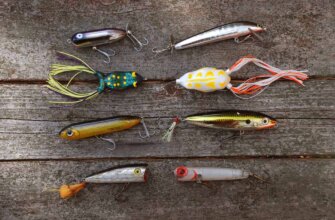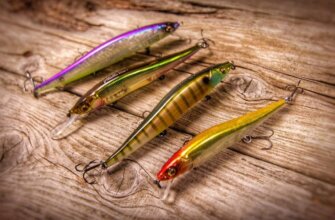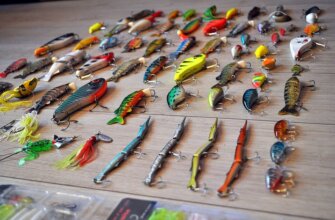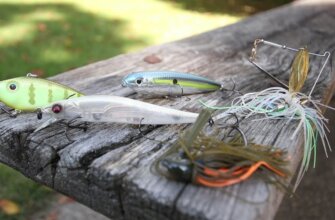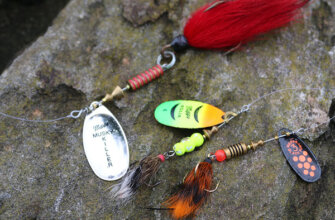Crappie fishing is a popular recreational activity that involves catching crappie, a type of freshwater fish that is found in lakes, rivers, and ponds across North America. Crappie are known for their delicious taste and can be caught using a variety of techniques, including jigging, trolling, and using live bait. The best time to catch crappie is during their spawning season, which typically occurs in the spring. Crappie fishing is a fun and challenging activity that requires patience, skill, and a bit of luck.
10 best crappie lures
When it comes to crappie fishing, there are numerous lures that can be effective. Here are 10 popular choices among anglers:
- Crappie Jigs. Jigs are versatile lures that can imitate small baitfish or insects. They come in various colors and sizes, allowing you to match the hatch and target crappie in different conditions.
- Crappie Tubes. These soft plastic lures resemble small baitfish or insects and are often used with jigheads. They have a lifelike action in the water and can be effective for enticing crappie to bite.
- Crankbaits. Crappie crankbaits are typically small, diving lures that imitate injured baitfish. They have a wobbling action that can attract crappie, especially when retrieved at varying speeds.
- Spinnerbaits. Spinnerbaits have a metal blade that rotates and creates flash and vibration in the water. They can be effective for crappie, particularly in murky or stained water conditions.
- Grubs. Crappie grubs are small soft plastic baits with a curly tail. They can be rigged on a jighead or used as a trailer on a spinnerbait or jig. Grubs come in a variety of colors and can be productive for crappie fishing.
- Beetle Spins. Beetle spins consist of a small spinner attached to a jighead with a soft plastic grub or body. They are known for their fish-attracting flash and can be effective for crappie, especially in shallow water or around cover.
- Marabou Jigs. Marabou jigs feature a feather-like material that provides a lifelike action in the water. The flowing motion of the marabou can entice crappie to strike.
- Inline Spinners. Inline spinners are small lures with a spinning metal blade and a treble hook. They can imitate small baitfish or insects and are effective for crappie fishing, especially in clear water.
- Minnow Imitations. Various lures are designed to imitate small minnows, which are a primary food source for crappie. These lures may include swimbaits, jerkbaits, or soft plastic minnow imitations.
- Live Bait. While not technically a lure, live bait such as minnows or worms can be highly effective for crappie fishing. Using live bait on a small hook or jig can entice crappie to bite.
Crappie Jigs
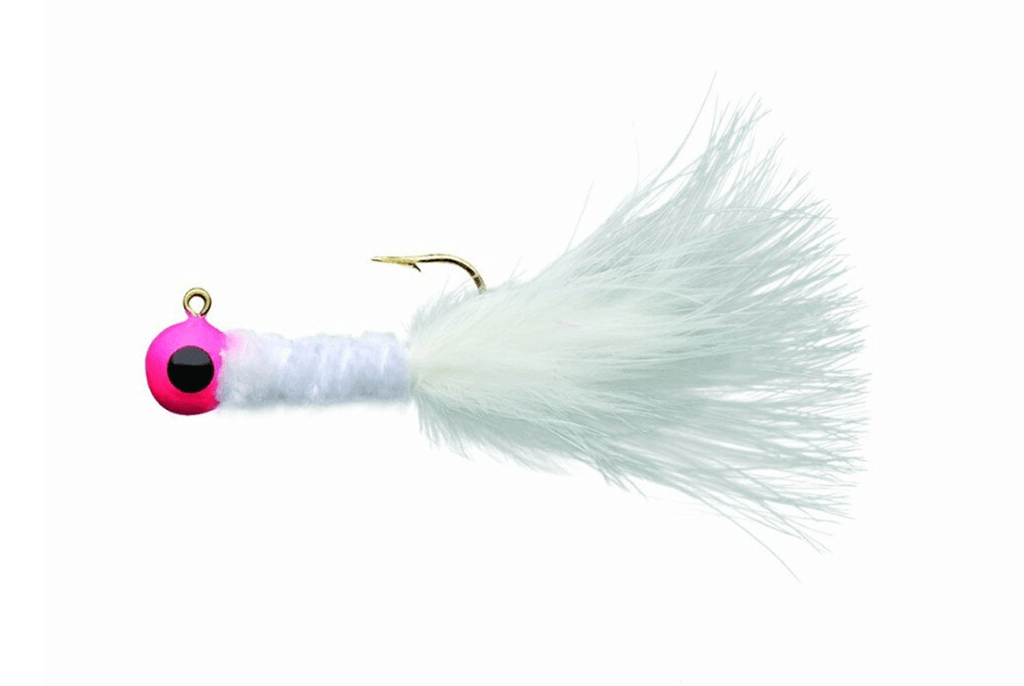
Crappie jigs are versatile and popular lures specifically designed to target crappie. They consist of a lead or tungsten jig head with a hook, typically adorned with a soft plastic body or skirt. Here is a description of crappie jigs without listing specific examples:
Crappie jigs come in various sizes, weights, and colors to mimic the natural prey of crappie and cater to different fishing conditions. The jig head is typically painted or coated with a durable finish and may feature realistic eyes for added visual appeal. The hook size can vary depending on the jig’s intended use and the size of crappie you’re targeting.
The soft plastic body or skirt attached to the jig head is often made of silicone, rubber, or similar materials. It may resemble a minnow, shad, or other small baitfish, or it can imitate insect larvae or other aquatic creatures. The body can be paddle-tailed, curly-tailed, straight, or have other unique shapes to produce enticing swimming or vibrating actions.
Crappie jigs are commonly fished by casting, vertically jigging, or trolling. When casting, you can target specific structures such as submerged trees, brush piles, weed beds, or drop-offs where crappie tend to congregate. Vertical jigging involves lowering the jig into the water column and imparting a jigging motion to entice crappie below. Trolling crappie jigs behind a boat allows you to cover larger areas and locate schools of crappie.
The presentation of crappie jigs can be further enhanced by adding live bait, such as a minnow or a piece of worm, to the jig’s hook. This combination can increase the jig’s attractiveness and entice reluctant or finicky crappie to bite.
Crappie jigs are effective throughout the year, but their popularity peaks during the spring spawning season when crappie are more active and feeding aggressively. However, they can be productive in any season and are particularly effective when crappie are holding tight to structure or suspending in open water.
When using crappie jigs, it’s important to match the size and color of the jig to the prevailing conditions, including water clarity, light conditions, and the size of the baitfish crappie are feeding on. Experimenting with different jigging techniques, depths, and retrieval speeds can also help you dial in on what works best on a given day.
Crappie Tubes
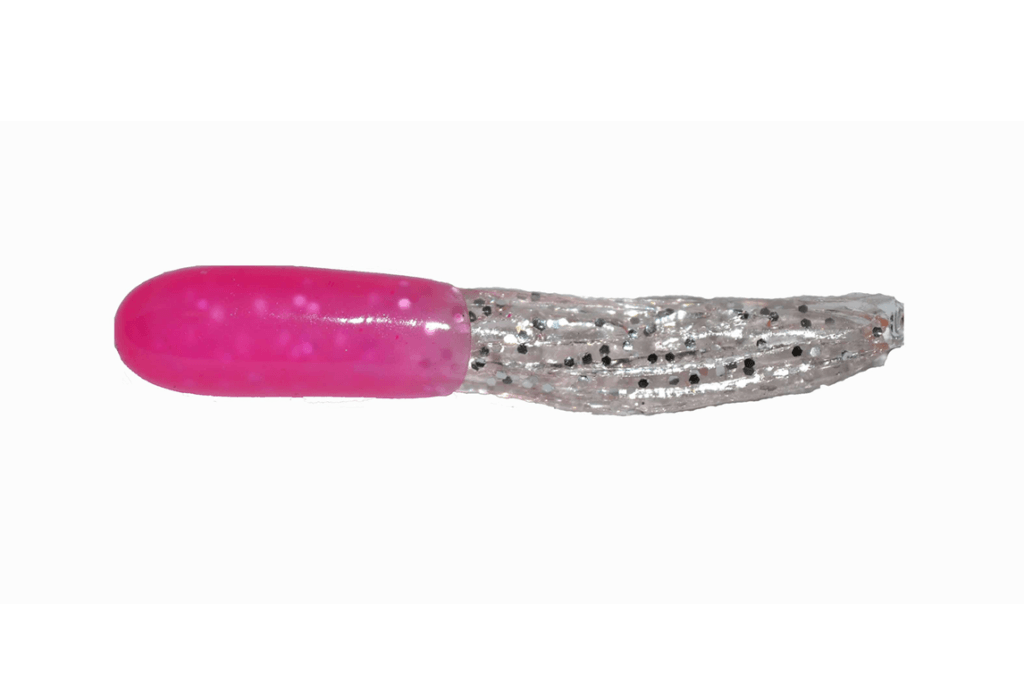
Crappie tubes are popular and versatile lures used specifically for targeting crappie. They are tube-shaped soft plastic baits that mimic various types of prey, such as minnows, insects, or small baitfish. Here is a description of crappie tubes without listing specific examples:
Crappie tubes consist of a hollow, cylindrical body made of soft plastic, usually with a solid head and a skirted or tentacle-like tail. The body may be solid or have a hollow cavity that can be filled with scent or attractant for added appeal. The tubes come in various lengths, colors, and patterns to imitate different forage species and match the fishing conditions.
The hollow body of the crappie tube allows for easy rigging on a jig head or other hooks. The head of the tube is typically threaded onto the hook, while the skirted or tentacle tail extends behind it, providing lifelike movement and enticing action in the water. The tail may be tapered, curly, or have appendages that flutter or undulate to mimic the motion of live prey.
Crappie tubes are versatile in their applications and can be fished in various ways. They can be cast and retrieved, vertically jigged, or used in combination with other techniques like spider rigging or trolling. They are effective when targeting crappie around structure, such as submerged brush piles, docks, weed beds, or standing timber.
When fishing with crappie tubes, it’s important to experiment with different retrieves, speeds, and depths to find what triggers the most bites. Varying the speed of your retrieve, adding pauses, or imparting subtle twitches can mimic the movements of injured or fleeing prey and entice crappie to strike.
Crappie tubes can be fished alone or in tandem with other lures or live bait to increase their attractiveness. They are also commonly used in combination with a jig head, allowing for precise casting and control over the depth at which you fish.
The size and color of the crappie tube should be matched to the prevailing fishing conditions, including water clarity, light conditions, and the size of the baitfish or prey crappie are feeding on. Natural colors like white, chartreuse, yellow, or silver are popular choices, but experimenting with different colors can help you determine what works best on a given day.
Crankbaits
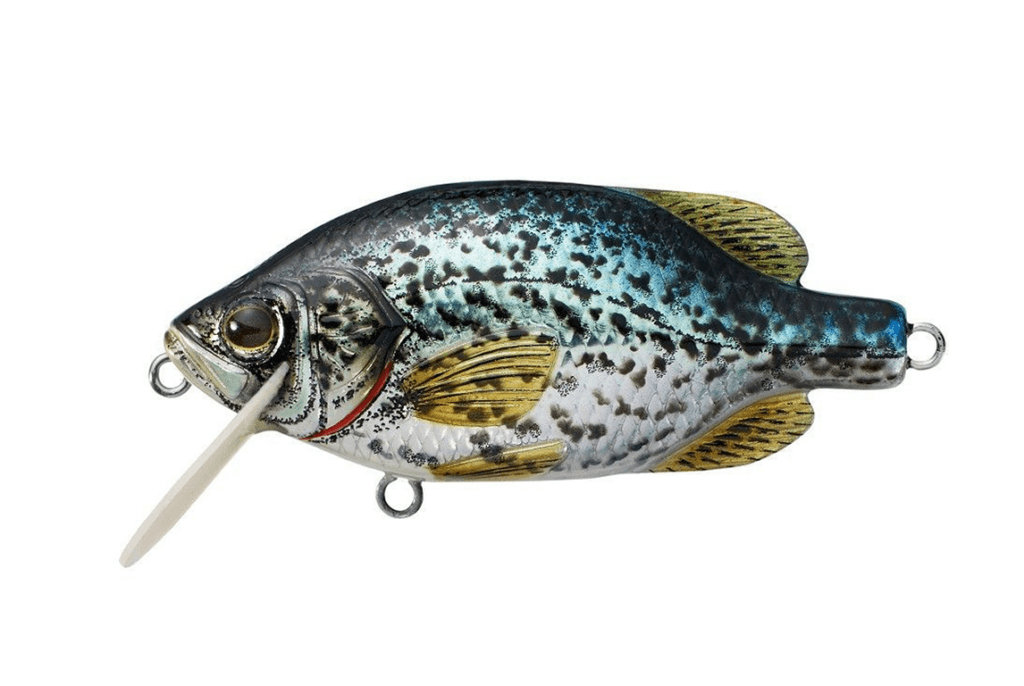
Crankbaits are effective lures for targeting crappie and can be a versatile choice in various fishing situations. Here is a description of crankbaits for crappie without listing specific examples:
Crankbaits for crappie are typically small to medium-sized lures that imitate baitfish, insects, or other prey species. They consist of a hard plastic body with a diving lip attached to the front. The diving lip is designed to make the lure dive to specific depths when retrieved.
Crankbaits come in a variety of shapes, sizes, and colors to mimic different types of forage and match the fishing conditions. Some crankbaits have a round, shad-like body shape, while others may have a more slender or flat-sided profile. The colors can range from natural baitfish patterns to bright and flashy options that attract the attention of crappie.
The diving lip on a crankbait determines its diving depth. Crankbaits for crappie usually have a shallow to medium diving depth, making them suitable for fishing in various water depths. The depth range is often indicated on the packaging or in the product specifications.
When fishing with crankbaits for crappie, you can cast them out and retrieve them at a steady pace or use a stop-and-go retrieve to imitate the movement of injured or fleeing prey. Crankbaits can also be trolled behind a boat or used in combination with a spider rig setup to cover a larger area and locate schools of crappie.
To enhance the effectiveness of crankbaits, anglers often experiment with different retrieval speeds, pauses, and variations in the retrieve pattern. Varying the speed can help trigger strikes from crappie that may be more responsive to a particular presentation.
Crankbaits for crappie are commonly used around structure and cover where crappie tend to congregate, such as submerged brush piles, standing timber, rock formations, or weed beds. By targeting these areas, you can increase your chances of enticing crappie to strike.
It’s important to select crankbaits that are appropriate for the size of crappie you are targeting. Smaller crankbaits are suitable for targeting black crappie or smaller white crappie, while larger crankbaits may be more effective for larger white crappie.
Spinnerbaits
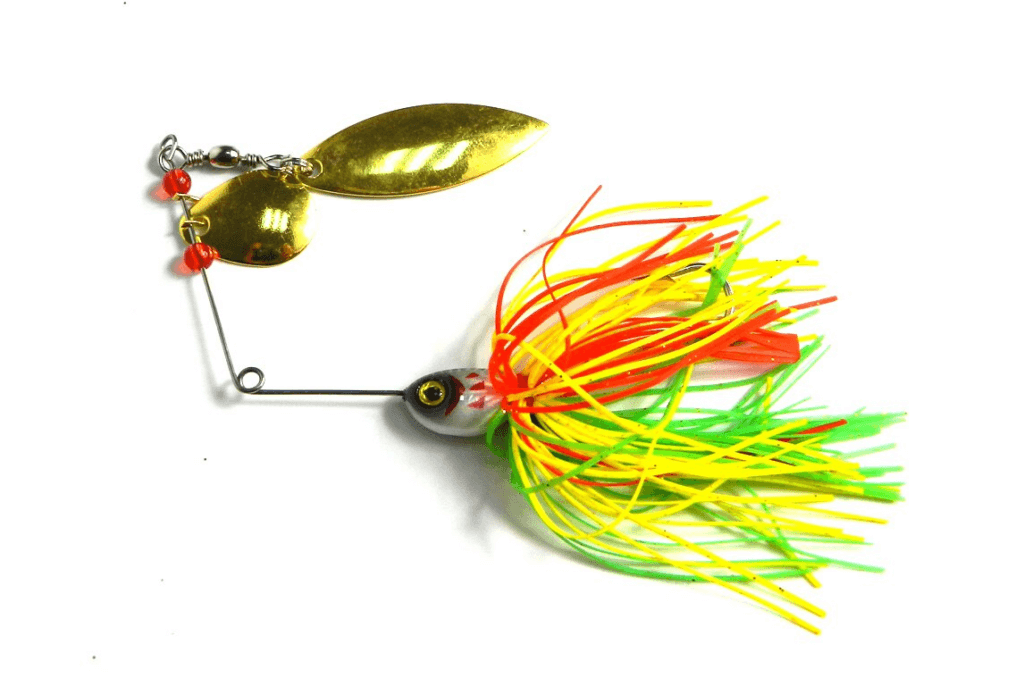
Spinnerbaits are versatile and popular lures for targeting crappie. They consist of a wire frame with a spinning metal blade and a skirted jighead. Here is a description of spinnerbaits for crappie without listing specific examples:
Spinnerbaits for crappie are designed to imitate small baitfish or other prey species that crappie feed on. They come in various sizes, colors, and blade styles to match the fishing conditions and the preferences of crappie.
The wire frame of a spinnerbait is typically bent in a V-shape, with one arm longer than the other. The longer arm holds the spinning metal blade, which creates flash and vibration in the water. The blade can be Colorado, Indiana, or Willowleaf-shaped, each producing a different level of vibration and flash.
Attached to the shorter arm of the wire frame is a skirted jighead. The jighead is often adorned with a soft plastic or silicone skirt that mimics the movement of a baitfish. The skirt provides additional attraction and helps create a lifelike presentation.
Spinnerbaits for crappie can be retrieved in various ways to imitate the movement of injured or fleeing baitfish. A steady retrieve can mimic a swimming or fleeing prey, while a stop-and-go retrieve with occasional pauses can imitate a wounded baitfish. Anglers often experiment with different retrieval speeds and pauses to determine the most effective presentation on any given day.
Spinnerbaits are effective in both open water and around structure or cover. They can be cast and retrieved near submerged brush piles, fallen trees, weed edges, or drop-offs where crappie may be hiding or feeding. Spinnerbaits can also be vertically jigged near standing timber or vertical structure when crappie are holding at specific depths.
The versatility of spinnerbaits allows anglers to cover a large area of water and locate active crappie. They are particularly effective during the pre-spawn and post-spawn periods when crappie are more aggressive and actively feeding.
When selecting spinnerbaits for crappie, consider using smaller sizes that match the forage in the area and the size of the crappie you are targeting. Lighter line and spinning or light casting tackle are commonly used with spinnerbaits for crappie fishing.
Grubs
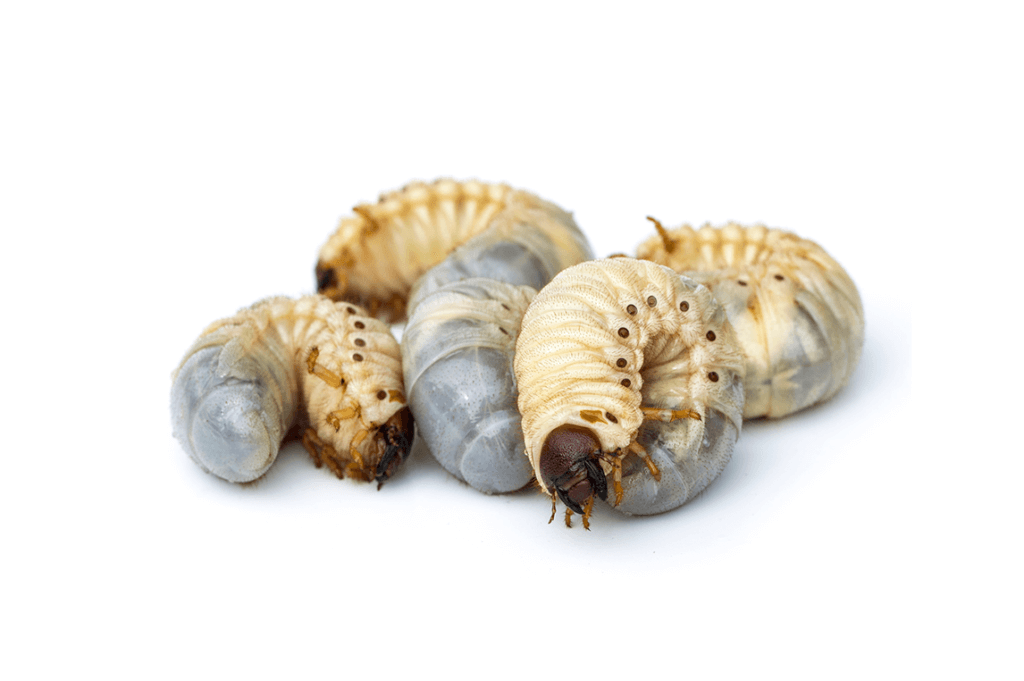
Grubs are highly effective soft plastic baits for targeting crappie. They are small, often between 1 to 2 inches in length, and feature a slender, elongated body with a curly tail. Here is a description of grubs for crappie without listing specific examples:
Grubs for crappie come in a wide variety of colors and patterns, allowing anglers to match the forage in their local waters or experiment with different presentations. They can imitate small minnows, insects, or other natural prey that crappie feed on.
The slender body of a grub has a ribbed or textured surface, which adds realism and creates subtle vibrations in the water. This action mimics the movement of live baitfish and triggers the predatory instincts of crappie.
At the end of the grub’s body, there is a curly tail that adds additional action and enticement. The tail flutters and undulates with even the slightest movement, creating lifelike movements that attract crappie.
Grubs can be rigged on a jighead or used as a trailer on various crappie lures, such as spinnerbaits or spoons. When rigged on a jighead, the grub’s body should be threaded onto the hook, leaving the tail free to provide enticing movement. Anglers can experiment with different jighead weights to achieve the desired depth and presentation.
The versatility of grubs allows them to be fished in various ways. They can be cast and retrieved, vertically jigged, or even trolled to cover large areas of water. Slow and steady retrieves with occasional pauses can imitate the natural movement of injured or fleeing baitfish, enticing crappie to strike.
Grubs are particularly effective when targeting crappie around structure or cover, such as submerged brush piles, fallen trees, weed edges, or docks. They can be presented at various depths, allowing anglers to target crappie holding at different water levels.
When selecting grubs for crappie, consider using smaller sizes and colors that match the local forage and water conditions. Lighter tackle, such as spinning or light casting gear, is commonly used with grubs for crappie fishing.
Beetle Spins
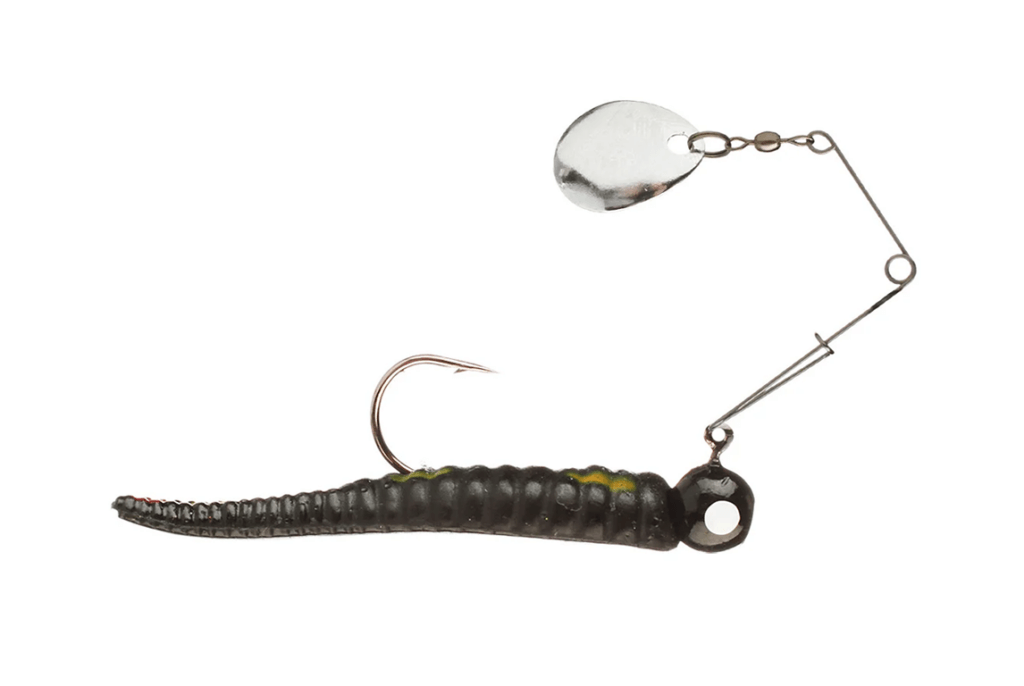
Beetle Spins are popular and productive lures for targeting crappie. They consist of a small, spinner-style blade attached to a wire arm, which is connected to a jighead. Here is a description of Beetle Spins for crappie without listing specific examples:
The design of Beetle Spins mimics the appearance and movement of a small baitfish or insect, making them highly enticing to crappie. The spinner blade creates flash and vibration in the water, attracting the attention of crappie and triggering their predatory instincts.
The jighead on a Beetle Spin is often adorned with a soft plastic grub or curly tail, which adds additional attraction and movement. The combination of the spinner blade and the soft plastic tail creates a lifelike and irresistible presentation for crappie.
Beetle Spins come in various sizes and colors, allowing anglers to match the local forage and water conditions. The blade color can range from silver and gold to more vibrant and contrasting colors. The soft plastic tails are available in different patterns and shades to imitate natural prey.
When fishing with Beetle Spins for crappie, cast them out and retrieve them at a slow to moderate pace. The spinner blade creates flash and vibration as it spins, attracting crappie from a distance. The soft plastic tail adds enticing movement, resembling the action of a swimming baitfish or insect.
Beetle Spins are effective when fished near structure or cover where crappie tend to gather, such as submerged brush piles, weed beds, or fallen trees. They can be presented at various depths by adjusting the retrieve speed and using different weights of Beetle Spins.
The versatility of Beetle Spins allows them to be used in different fishing techniques. They can be cast and retrieved, vertically jigged, or even trolled to cover larger areas. Experimenting with different retrieves and depths can help determine the most effective presentation for crappie in a given situation.
When selecting Beetle Spins for crappie, it is advisable to have a variety of sizes and colors in your tackle box. Light to ultralight spinning or casting gear is commonly used with Beetle Spins for crappie fishing.
Overall, Beetle Spins are reliable and productive lures for crappie fishing. Their combination of flash, vibration, and lifelike movement makes them irresistible to crappie. By adjusting the retrieve speed, depth, and color selection, anglers can optimize their success and enjoy a rewarding day on the water.
Marabou Jigs
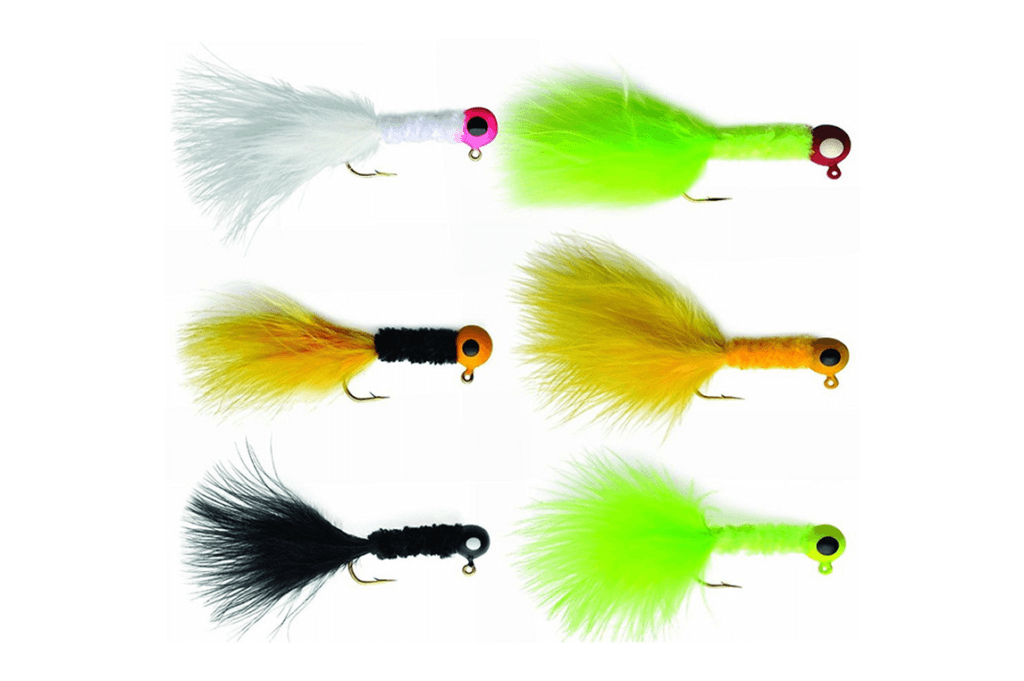
Marabou jigs are popular and effective lures for targeting crappie. They consist of a jighead adorned with a fluffy marabou feather skirt. Here is a description of marabou jigs for crappie without listing specific examples:
Marabou jigs are designed to mimic small baitfish or insects, which are natural prey for crappie. The marabou feathers create a lifelike appearance in the water, providing enticing movement and attracting the attention of crappie.
The jighead on a marabou jig is typically weighted to ensure proper sinking and control during retrieval. It can come in various colors and sizes, allowing anglers to match the local forage and water conditions. Common colors for marabou jigs include white, chartreuse, pink, and black.
When fishing with marabou jigs for crappie, they can be presented in various ways. One popular method is to cast the jig near submerged structure or cover, such as brush piles, docks, or overhanging vegetation. The jig can be retrieved with a slow and steady pace or using a series of twitches and pauses to imitate the movement of injured prey.
Marabou jigs are also effective when vertically jigged, especially when crappie are holding in deeper water or suspended at a certain depth. This technique involves dropping the jig vertically below the boat or structure and imparting a subtle up-and-down motion to entice crappie to strike.
The versatility of marabou jigs allows them to be used in different fishing techniques. They can be fished with a float or bobber, which suspends the jig at a desired depth, or tipped with live bait such as minnows or worms to add extra scent and attraction.
The size of marabou jigs can vary depending on the target crappie’s preferences and the fishing conditions. Smaller sizes, typically ranging from 1/32 to 1/8 ounce, are commonly used for crappie fishing.
Marabou jigs are most effective when fished with light to ultralight spinning or casting gear. They can be used by anglers of all skill levels, including beginners, and are a popular choice for ice fishing as well.
Inline Spinners
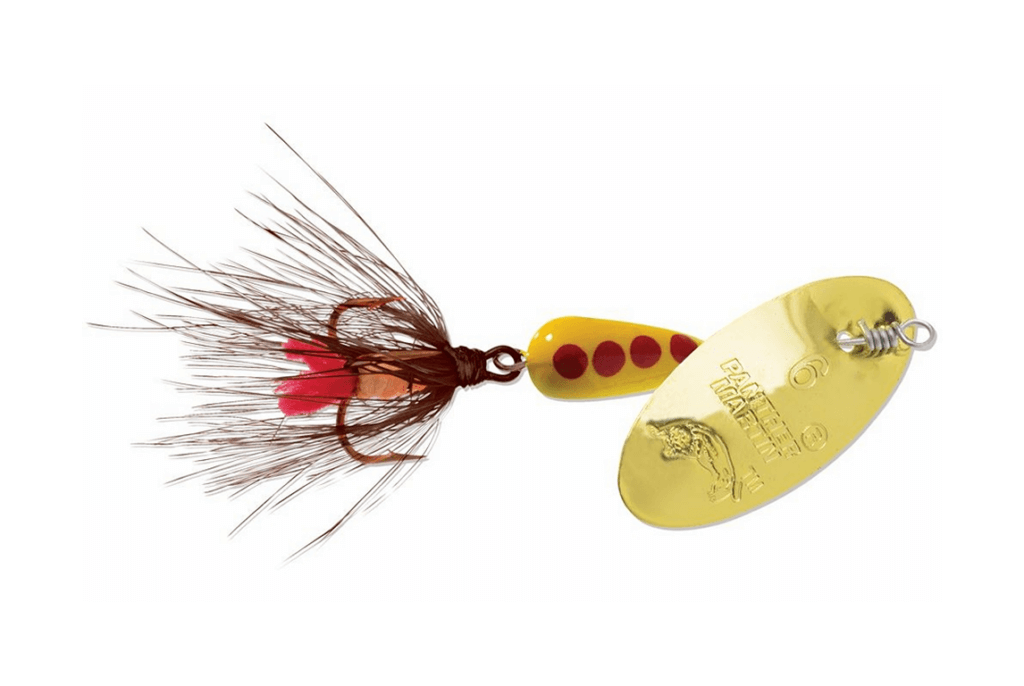
Inline spinners are effective lures for targeting crappie. They consist of a rotating blade attached directly to the fishing line, followed by a small body or soft plastic trailer. Here is a description of inline spinners for crappie without listing specific examples:
Inline spinners are designed to imitate small baitfish or insects, which are natural prey for crappie. The rotating blade creates flash and vibration in the water, attracting the attention of crappie and triggering strikes.
The blade on an inline spinner can come in various shapes and colors, such as Colorado, Willow, or Indiana blades, and can be silver, gold, or painted with patterns. The blade’s rotation creates visual appeal and adds a thumping action that entices crappie to strike.
Inline spinners typically have a small body or soft plastic trailer attached to the rear. The body can mimic a minnow, shad, or other small baitfish, while the soft plastic trailer may imitate a tail or appendages of a prey. Common colors for inline spinner bodies and trailers include white, chartreuse, yellow, and black.
When fishing with inline spinners for crappie, they can be casted or trolled. Casting is suitable for targeting specific structures or cover, such as brush piles, fallen trees, or docks, while trolling is effective for covering larger areas of water.
During the retrieve, the inline spinner can be retrieved at a steady pace, allowing the blade to spin and create flash and vibration. Alternatively, a stop-and-go retrieve with occasional twitches or pauses can simulate the erratic movement of injured prey, which can trigger strikes from crappie.
Inline spinners can be fished at different depths depending on the weight of the lure, the speed of retrieval, and the depth of the target area. They are versatile lures that can be used in both shallow and deeper water, depending on the desired presentation.
Minnow Imitations
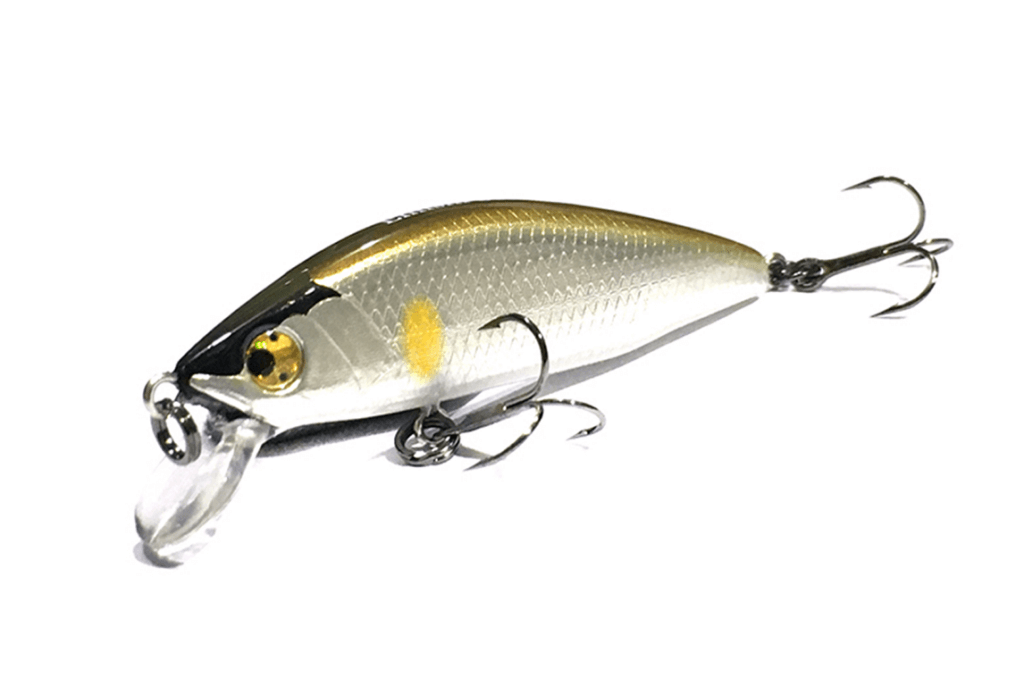
Minnow imitations are highly effective lures for targeting crappie. These lures are designed to mimic the appearance and swimming action of small baitfish, which are a primary food source for crappie. Here is a description of minnow imitations for crappie without listing specific examples:
Minnow imitations come in a variety of forms, including hard plastic crankbaits, soft plastic swimbaits, and jerkbaits. They are typically designed with lifelike details such as realistic eyes, scales, and fins to closely resemble actual minnows.
The size of the minnow imitation lure should match the size of the baitfish in the crappie’s diet. Smaller sizes are generally preferred, ranging from 1 to 3 inches in length, although larger sizes can also be effective depending on the specific fishing conditions.
Minnow imitations may feature a diving lip or be designed to suspend at a certain depth in the water column. This allows anglers to target crappie at different depths depending on their feeding preferences and the location of the fish.
During the retrieve, minnow imitations can be worked in a variety of ways to imitate the erratic swimming patterns of real baitfish. Techniques such as steady retrieves, pauses, twitches, and jerks can all be effective in enticing crappie to strike.
Colors of minnow imitations can vary, but natural patterns like silver, gold, white, and chartreuse tend to be popular choices. These colors closely resemble the appearance of small baitfish and can trigger a feeding response from crappie.
Minnow imitations can be used in various fishing situations, including casting around submerged structure, trolling along drop-offs or weed edges, and vertically jigging in deeper water. They are versatile lures that can be effective in both open water and tight cover.
When fishing with minnow imitations for crappie, it is important to match the lure to the conditions and adjust the presentation accordingly. Pay attention to the depth at which crappie are feeding and experiment with different retrieves and speeds to find the most effective approach.
Live Bait
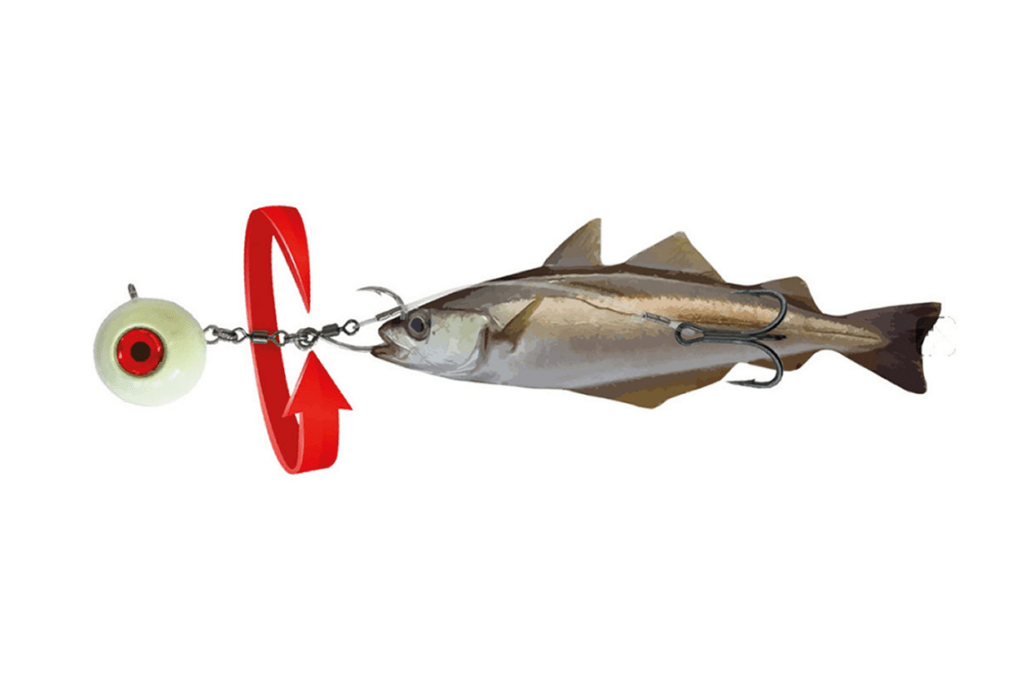
Live bait is a popular and effective choice for targeting crappie. Using live bait provides an opportunity to present a natural and enticing meal to crappie, increasing the chances of attracting bites. Here is a description of live bait options for crappie without listing specific examples:
Minnows are the most common and widely used live bait for crappie fishing. They closely resemble the natural forage of crappie and can be presented on a variety of rigs, such as a hook and split shot, a slip bobber rig, or a Carolina rig. Minnows can be fished at various depths and can be retrieved or suspended to entice crappie to strike.
Waxworms and mealworms are small larvae that can be used as live bait for crappie. They are commonly used when crappie are feeding on smaller prey items or during colder months when fish are less active. Waxworms and mealworms can be fished on a small hook or added to a jig for added attraction.
Crickets are another live bait option for crappie. They are particularly effective when crappie are feeding near the surface or in shallow water. Crickets can be fished on a hook or added to a small float rig to keep them suspended in the strike zone.
Earthworms, or nightcrawlers, are a versatile live bait that can attract a variety of fish species, including crappie. They can be fished on a hook, either threaded through or presented in a wiggling fashion, and can be effective when targeting crappie near the bottom or in areas with natural vegetation.
When using live bait for crappie, it’s important to consider the size of the bait in relation to the fish’s mouth. Crappie have relatively small mouths, so using smaller-sized live bait is generally recommended. Additionally, using a sensitive rod and line setup can help detect subtle bites and increase hook-up rates.
It’s worth noting that regulations regarding the use of live bait may vary depending on the fishing location. Always check local fishing regulations to ensure compliance with any restrictions or size limits for live bait usage.
Live bait can be an excellent choice for crappie fishing, as it presents a natural and enticing meal that crappie find hard to resist. By selecting the appropriate live bait, rigging it properly, and fishing it in the right locations, anglers can increase their chances of success when targeting crappie with live bait.

